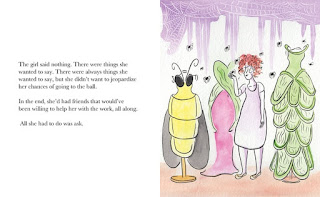Spiderella is an unusual CCS-related project, as it’s an illustrated
children’s book, not an actual comic. Of course, while CCS is known to focus on
storytelling in comics form above all else, there have been a number of
cartoonists who have focused on illustration or illustrated text. (Katherine
Roy comes to mind.) While at CCS, the two kicked around this story, which
combined aspects of Cinderella and the myth of Arachne but turned out to be
something closer to modern YA adventure comics in many respects. It was decided
that Petite would write the actual text and Holden would do the illustrations
and their accompanying watercolors. The 200 page book is at once a rapid read
but also surprisingly dense. It winds up being the first part of an
indeterminately long saga, yet it’s also a satisfying read on its own. Petite
and Holden create a beautiful storytelling rhythm, where the slightly poetic
and slightly silly language that Petite chooses is a perfect match for Holden’s
bright colors, exaggerated facial expressions and pointed use of gestural
drawing.
The latter is especially important in an illustrated book that’s
not a comic. The understanding of the way bodies interact in space that Holden
possesses gives each of her pages life, rather than feeling static, and it’s
because of the way she poses her characters and has them express body language
in the form of pointing, hunching their shoulders, or slyly staring off in a
direction counter to all the other action on the page. Holden also totally
leans into the fashion aspect of the story, with her creations more than rising
to the occasion of silliness (yet still fashionable) that Petite writes. For
his part, Petite’s omniscient narrator is funny without being too wacky,
informative without spelling everything out, and on top of the narrative while
still allowing a digression or two.
The story is about a young girl named Eleanor who has the
fantastic ability to sew very quickly and imaginatively for her boss, Minerva.
So much so that Minerva keeps her locked in an attic, where Eleanor is happy
because she can at least talk to her friends, the spiders. That mix of sweet
and creepy (it’s rare that spiders living in someone’s hair is considered to be
a nice thing in literature) also serves to make this book distinctive. While
much in the narrative is made to be deliberately familiar, Petite clearly is
interested in subverting typical fairy tale narratives in other ways. When the
King and Queen of the kingdom decree that their son, the Prince, must get
married, they declare a Royal Ball so that a proper bride can be chosen. That all
sounds pretty boilerplate, but Petite greatly deflects expectations at the ball
and especially with regard to the Prince. The ending of the story in particular
is a happy one, but in a manner that’s not common for typical fairy tales,
although Petite had been hinting at it throughout the book. What Spiderella
wanted more than anything was a chance at adventure (and being reunited with
her father, also an adventurer), and she earned that chance. And when the
Prince runs after her in this book, it’s not to guarantee her a life of luxury
like in Cinderella, but rather to beg to get away. I read the first twenty
pages of the book to my daughter, a sometimes squirmy listener, and she
demanded more. I read the first seventy pages out loud and she was rapt with
every page and made all sorts of predictions as the story proceeded.
(This drawing is by K.M. Claude.)
Also reviewed is a sketchbook rough in Petite’s My Biblical
Daydreams series, entitled “Clear As Day”. The story is about a writer who’s
apparently had a drunken encounter with a woman named Theda who expects him to
show up somewhere. The fact that he can’t quite recall everything the way it
was precisely recorded bothers him as a writer. He wanted perfect, clear
memories. So Theda talked to him about this and gave him water from the River
Lethe, the Greek underworld river of forgetfulness. (Its name means “oblivion”.)
It was good ol’ Death playing a little prank, as the water put his memories
where they could never be touched again, and she promised to come back later
for the rest. (Petite didn’t specify that this was death, but the anagram and
other clues made it obvious.) This was a clever short story with great
character design, and the modern touches were effective in deflecting the story’s
true aim until just the right moment.







No comments:
Post a Comment